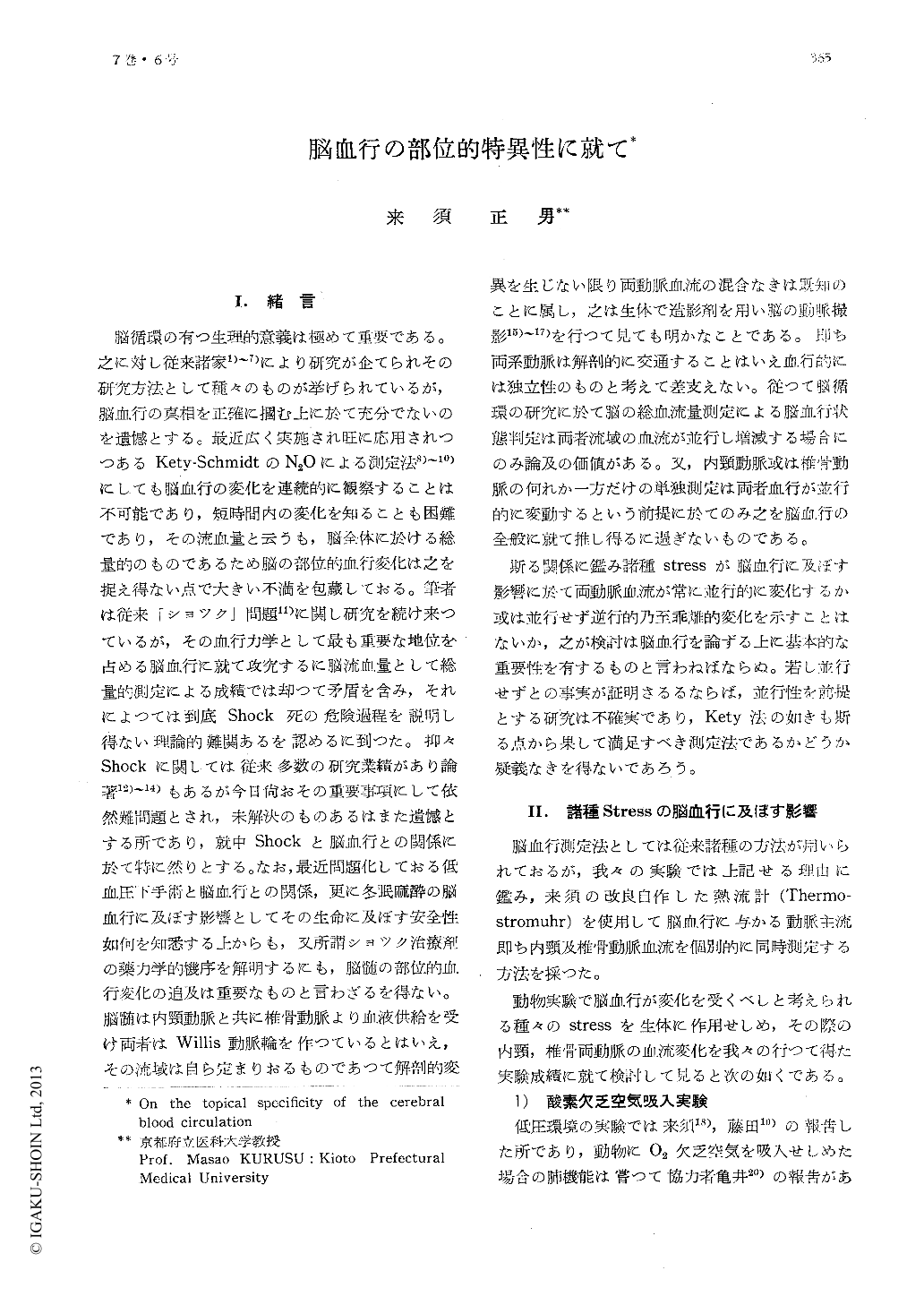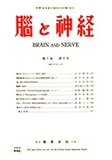Japanese
English
- 有料閲覧
- Abstract 文献概要
- 1ページ目 Look Inside
I.緒言
脳循環の有つ生理的意義は極めて重要である。之に対し従来諸家1)〜7)により研究が企てられその研究方法として種々のものが挙げられているが,脳血行の真相を正確に掴む上に於て充分でないのを遺憾とする。最近広く実施され旺に応用されつつあるKety-SchmidtのN2Oによる測定法8)〜10)にしても脳血行の変化を連続的に観察することは不可能であり,短時間内の変化を知ることも困難であり,その流血量と云うも,脳全体に於ける総量的のものであるため脳の部位的血行変化は之を捉え得ない点で大きい不満を包蔵しておる。筆者は従来「シヨツク」問題11)に関し研究を続け来つているが,その血行力学として最も重要な地位を占める脳血行に就て攻究するに脳流血量として総量的測定による成績では却つて矛盾を含み,それによつては到底Shock死の危険過程を説明し得ない理論的難関あるを認めるに到つた。抑々Shockに関しては従来多数の研究業績があり論著12)〜14)もあるが今日尚おその重要事項にして依然難問題とされ,未解決のものあるはまた遺憾とする所であり,就中Shockと脳血行との関係に於て特に然りとする。なお,最近問題化しておる低血圧下手術と脳血行との関係,更に冬眠麻酔の脳血行に及ぼす影響としてその生命に及ぼす安全性如何を知悉する上からも,又所謂シヨツク治療剤の藥力学的機序を解明するにも,脳髄の部位的血行変化の追及は重要なものと言わざるを得ない。脳髄は内頸動脈と共に椎骨動脈より血液供給を受け両者はWillis動脈輪を作つているとはいえ,その流域は自ら定まりおるものであつて解剖的変異を生じない限り両動脈血流の混合なきは既知のことに属し,之は生体で造影剤を用い脳の動脈撮影15)〜17)を行つて見ても明かなことである。即ち両系動脈は解剖的に交通することはいえ血行的には独立性のものと考えて差支えない。従つて脳循環の研究に於て脳の総血流量測定による脳血行状態判定は両者流域の血流が並行し増減する場合にのみ論及の価値がある。又,内頸動脈或は椎骨動脈の何れか一方だけの単独測定は両者血行が並行的に変動するという前提に於てのみ之を脳血行の全般に就て推し得るに過ぎないものである。
斯る関係に鑑み諸種stressが脳血行に及ぼす影響に於て両動脈血流が常に並行的に変化するか或は並行せず逆行的乃至乖離的変化を示すことはないか,之が検討は脳血行を論ずる上に基本的な重要性を有するものと言わねばならぬ。若し並行せずとの事実が証明さるるならば,並行性を前提とする研究は不確実であり,Kety法の如きも斯る点から果して満足すべき測定法であるかどうか疑義なきを得ないであろう。
The author undertook an experimental study on the alteration of the blood circulation of the brain under various influences. To this purpose, A. carotis interna and A. vertebralis of many dogs and rabbits were equipped with thermo-elements of the thermostromuhr, and each blood flow was simultaneously measured. At the same time, the variation of the blood presure was optically registered.
As the results of various experiments the author roughly points out the following items:
(1) In order to secure the accurate state of condition on the blood circulation of the brain, it is necessary to measure each blood flow of A. carot. int. and A. vert. respectively and simultaneously.
(2) When the variation occurs of the blood circulation of the brain under various influences, the blood flow of A. carot. int. and A. vert. does not always fluctuate in parallel. According to the types of Stress, the author confirms that there is discrepancy present, that is, when one increases the other decreases, and when one decreases the other increases and that both of them run contrary to each other.Consequent-ly the author recongnized that the systems of both arteries were of different hemodynamic nature.
(3) The blood flow of both arteries together increases when inhalation of air of oxygen deficiency and inhalation of mixtures of carbon dioxide. The adrenalin-shock causes likewise similar changes.
(4) The blood flow of A. vert. decreases but the blood flow of A. carot. int. increases, on the cotrary, such as in cases of traumatic, hemorrhagic, burnt, and electrical shocks.
(5) The blood flow of both arteries together decreases when in cases of histamine and acetylcholine shock, also due to the fall of blood pressure from application of the fresh extract of crushed muscle, and ATP and AMP.
(6) The blood flow of both arteries takes the worse turn also in cases of neurogenic shock caused by blow upon the sensitive parts of the body. According to the shock of con-tinued stimulation exerted on the hypothalamus, the blood flow becomes discrepant in its last stage, and the blood flow of A. vert. alone turns worse.
(7) The ether narcosis causes slight discre-pancy, that is, the blood flow of A. carot, int. increases while that of A. vert. decreases. At the use of the barbiturate derivatives the res-ponses of both arterial systems are similar to ether except a tendency of greater discrepancy in the former case.
(8) If the artificial hypotension, by means of hexamethonium bromide (C6) or hibernation narcosis are regulated moderately, A. vert, is well maintained although the blood flow of A. carot. int. decreases.
(9) By the application of the therapeutic medicaments, such as norepinephrine, neosyne-phrine and theraptique, the blood flow of A. vert. increases markedly and likewise blood pressure and respiration are excited. At that time, however the blood flow of A. carot. int. decreases on the contrary.
(10) From a hemodynamic view-point, as a significant pattern for the dagerous stage in shock, the author emphasizes that the most important change is the reduction of blood flow of A. verd. which runs through the medulla oblongata and the mid-brain including the area of the vital center, and the recovery of its blood flow relieves the organism from the dangerous stage of shock.

Copyright © 1955, Igaku-Shoin Ltd. All rights reserved.


